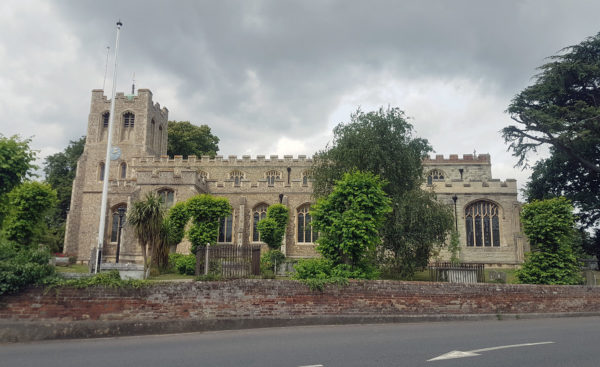A small picture-postcard type village in Essex is home to some remarkable historical buildings, many of which can be visited
Grange Barn
On the edge of the village is Grange Barn, a huge 13th-century barn built for the nearby abbey by the Cistercians, and said to be one of the oldest surviving timber-framed buildings in the UK.
It nearly didn’t survive though, as with many farmers, more interested in farming than heritage, it was left to ruin in the 1950s-70s and an application was made in 1981 to demolish it entirely.
“I have inspected this ruin. Each councillor should do the same before taking any further action. Its condition makes restoration unthinkable” – letter to the local paper March 1981.
Fortunately, the local council disagreed, forced the owner to sell, demolished his ugly modern barn next door and set about restoring it. The barn today looks as handsome as a massive and ancient barn can look, even if in truth, much of its modern restoration.
Do look for the door in the corner, which no one can work out why it’s there, and there are some informative display boards about the restoration. There’s honestly not a lot else to see – a small shed nearby has an exhibition about a local woodworker, but that’s about it. It’s pleasant enough to visit, and if in the area, foolish to miss.
Today the barn is managed by the National Trust, and entry to the barn is free for members, or included in the price to nearby Paycocke’s House.
Paycocke’s House
If someone said to you “show me a stereotypical Tudor mansion”, then this packs a wallop of a delivery.
Built around 1500 by a rich wool merchant, possibly as a wedding present for his son (!), it’s a huge building lined with enough carvings in the wood outside to keep you busy for an hour, and you haven’t even gone inside yet.
The house was sold around 1584 to the Buxton family, and they kept it until 1746 when it was sold as three separate homes, but by the 19th-century, it was falling into a state of decay.
A campaign was launched to save it as developers wanted the timbers, and Lord Noel Buxton was asked to help out, and he did more than that – he bought the house outright. Although historians were aghast at his plans to restore it, he found a local craftsman who loved the building and handed it over to him to work on.
And historical exactitude aside, it’s a stunning restoration. OK, the staircase is clearly modern, but that’s simply reflective of the building’s evolving history. The rest of the building is pure Tudor restoration, all woody and decorative and creaky and terrifically wonderful.
Some of the rooms are set out as they might have been in the time, with dining tables, beds, and the like – and one room is given over to someone who lived here for a short while, the socialist campaigner Conrad Noel.
There’s a lovely garden at the back, a second-hand bookshop inside, and a modest little cafe overlooking the garden.
Today Paycocke’s House is managed by the National Trust, and entry to the barn is free for members, or included in the price to nearby Grange Barn.
St Peter-ad-Vincula
Depending on how you think about such things, this is either a very big church, or a very small cathedral. It’s not actually a cathedral, but very nearly was.
The church is 15th-century, and owes its size to the wealth of the area based on the wool trade. Damaged during WW2, it’s today an oversized parish church, although clearly very well used by the local community.
There are some old graves on the floor with the sort of brass decorations that generations of children have used for brass rubbings, and the graveyard outside is huge and packed full of stones to look at.
There’s not a huge amount of note other than its size, although the roof is notable, being made of copper which has turned green over the ages, and very distinctive — from Google satellite view.
Coggeshall village centre
The village centre seems to have arrived in the 1500s, and sort of stopped about there, as it’s packed full of very old buildings, many with exceptional amounts of decorative plasterwork and woodwork.
It’s not all totally ancient though. The surrounds are modern housing, and right in the centre of town, near Paycocke’s House is a Festival of Britain bench from the 1950s.
Elsewhere, there are remnants of former waterways that pass through the centre of the village – some covered over, but many decoratively still flowing between houses.
Coggeshall Abbey
This is the bit you can’t just wander in and visit alas, as the former abbey and grounds are now privately owned. You can book a visit though if you’re a member of Historic Houses on one of their arranged visits.
There is also nearby St Nicholas’ Chapel, which seems difficult to be sure if private or not, but frankly, on my visit, my feet were by now screaming for a break, so that’s for another day.
How to get to Coggeshall
There are no direct trains, and the nearest station is in Kelvedon, which is about 2.5-3 miles from Coggeshall by bike/walking.
An alternative is to take the route 70 bus, which runs fairly regularly between Braintree and Colchester.
















